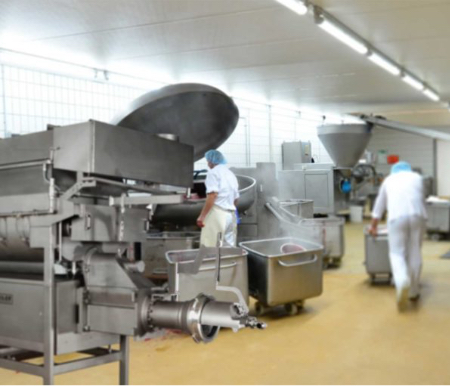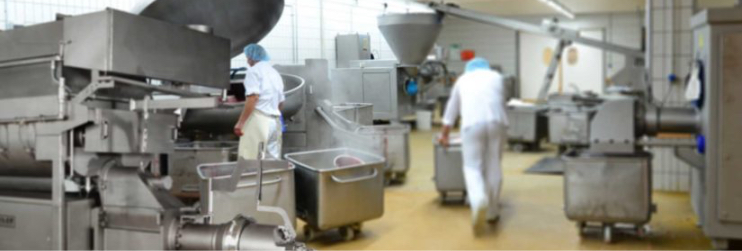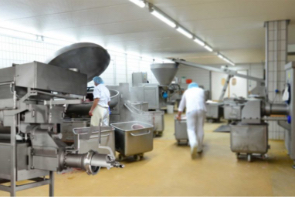Originally published on AirgasThinks.com | December 5, 2018



Whether you’re running a massive facility or just putzing around the kitchen at home, the same general food handling rules apply. Here’s a simple example:
Momma’s making meatballs in the kitchen. She puts ground meat, an egg, a splash of milk, some bread crumbs and a few seasonings in a bowl—then she mixes it all together with her hands. She rolls the mixture into balls and lines them up in neat rows, one by one, on a well-oiled pan. And what does momma do next?
She washes her meaty hands, of course.
Seems pretty obvious, right? Anything that comes into contact with raw meat should be cleaned before it touches anything else. But if you’re processing thousands of pounds of raw meat every day, the simple concept may be overpowered by a large-scale, complex process. More contact points mean more areas to keep clean—especially those hard-to-reach places.
The food industry is no stranger to the importance of hygiene and what can happen when it’s not maintained. The World Health Organization (WHO) reports that every year “almost 1 in 10 people in the world fall ill after eating contaminated food and 420,000 die.” And in 2017, the FSIS recalled over 20 million pounds of meat products. With such serious consequences in the mix, industry-leading food manufacturers look closely at their processes to find any possible area where hygiene could be compromised. Still, one piece of equipment often evades them.
Connect with an Airgas expert for more help, insights and solutions.
Consistent and efficient, bottom injection chilling is among the most popular cooling methods currently used for industrial mixers. The design of some nozzles, however, makes removal for regular inspection and cleaning difficult—which is more problematic than many plant operators realize. The liquid cooling agent (nitrogen or carbon dioxide) is injected into the meat just fine, but, over time, meat often finds its way into the nozzle as well. And it’ll stay there, presenting a hygiene issue for every subsequent batch of meat that runs through the mixer.
According to Bill Adams, Director of Food and Pharmaceuticals at Airgas, most plants clean the outer surface of their bottom injection nozzles, but may be unaware of how sanitary the nozzles may be inside if they don’t take them apart for cleaning every day. “They don’t take it apart every day and they don’t clean it every day,” Adams laments.
It may not seem like a serious problem, but a nozzle with retained meat contains microorganisms, which can contaminate the product in the mixer—leading to the potential for a recall. And once the plant staff sees the residue in the nozzle for themselves, it’s hard to ignore. Stephen Bilger, Airgas’ Director of Equipment Solutions, adds: “If you don’t know, you don’t know. But it can’t be unlearned.”
In 2002, the North American Meat Institute (NAMI) published 10 Principles of Sanitary Equipment Design (and released updated issues since). They cover everything from choosing the right materials to avoiding liquid collection. But at the heart of it all is making sure every piece of equipment is easily inspected and cleaned. So if your bottom injection nozzle is hard to inspect, you’re not just failing to extract old meat from a cylinder. You risk going against nearly two decades of established industry best practices.
No one can be blamed for not addressing an issue they’re not aware of—but once you know, it’s time to act. This is a no-brainer in an industry so dedicated to hygiene. Once aware of the meat in their nozzles, manufacturers always ask: What’s the best way to address it?
You could consider a different cooling option—there’s no shortage of alternatives—but few methods are as consistent as nitrogen or carbon dioxide bottom injection.
Snow horns? A waste of gas and a potential condensation risk. Ice? Inconsistent temperature control (plus it melts, leaving water behind). Frozen product to cool down fresh product? Unsustainable. Jacketed mixers with refrigerant cooling? Adds capital and complexity to mixer, and has limitations in temperature removal. All of these methods lead to variations in quality from batch to batch, potentially harming your product and your reputation.
When it’s well designed and easy to take apart, a bottom injection system is clearly the best choice. If you find your nozzle is too hard to clean, talk to your gas supplier about hardware options. If they can’t provide a simple, easy-to-clean solution, expand your search elsewhere.
If you’ve got an inspectable nozzle in place, Adams and Bilger recommend taking a look as often as possible. For many facilities, that means after every shift. “After the break in production, if there is an issue with nozzles or other equipment, they only need to recall one shift’s worth of products,” Adams suggests. “It limits the potential for a larger quality issue.”
Potential for contaminated bottom injection nozzles is just one more thing to stay cognizant of moving forward. As the industry progresses and our benchmarks for sanitary practices evolve, leaders are always looking for new ways to improve product quality and consistency. Why not take a look inside the nozzle? After all, when it comes to the success of your business, every little thing counts.